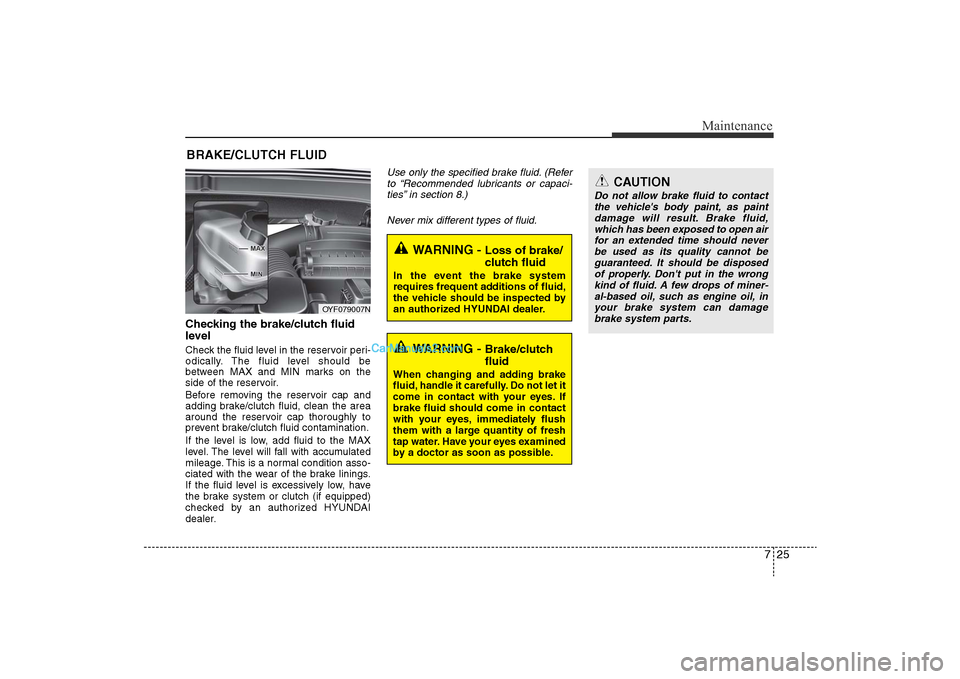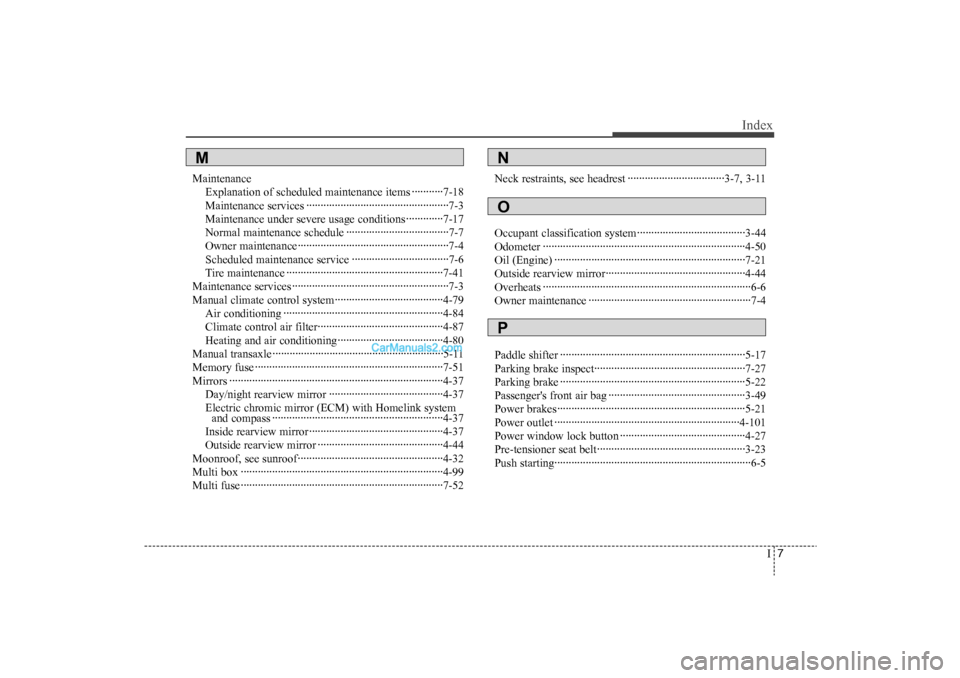2011 Hyundai Sonata engine oil
[x] Cancel search: engine oilPage 310 of 380

Maintenance22
7Changing the engine oil and filterHave engine oil and filter changed by an
authorized HYUNDAI dealer according to
the Maintenance Schedule at the begin-
ning of this section.
CALIFORNIA
PROPOSI-
TION 65 WARNING
Engine oil contains chemicals
known to the State of California to
cause cancer, birth defects, and
reproductive harm.
Used engine oil may cause irrita-
tion or cancer of the skin if left in
contact with the skin for prolonged
periods of time. Used engine oil
contains chemicals that have
caused cancer in laboratory ani-
mals. Always protect your skin by
washing your hands thoroughly
with soap and warm water as soon
as possible after handling used oil.
YF HMA 7.QXP 11/25/2009 1:45 PM Page 22
Page 313 of 380

725
Maintenance
BRAKE/CLUTCH FLUIDChecking the brake/clutch fluid
level Check the fluid level in the reservoir peri-
odically. The fluid level should be
between MAX and MIN marks on the
side of the reservoir.
Before removing the reservoir cap and
adding brake/clutch fluid, clean the area
around the reservoir cap thoroughly to
prevent brake/clutch fluid contamination.
If the level is low, add fluid to the MAX
level. The level will fall with accumulated
mileage. This is a normal condition asso-
ciated with the wear of the brake linings.
If the fluid level is excessively low, have
the brake system or clutch (if equipped)
checked by an authorized HYUNDAI
dealer.
Use only the specified brake fluid. (Referto “Recommended lubricants or capaci-ties” in section 8.)
Never mix different types of fluid.
WARNING -
Brake/clutch
fluid
When changing and adding brake
fluid, handle it carefully. Do not let it
come in contact with your eyes. If
brake fluid should come in contact
with your eyes, immediately flush
them with a large quantity of fresh
tap water. Have your eyes examined
by a doctor as soon as possible.
WARNING -
Loss of brake/
clutch fluid
In the event the brake system
requires frequent additions of fluid,
the vehicle should be inspected by
an authorized HYUNDAI dealer.
CAUTION
Do not allow brake fluid to contactthe vehicle's body paint, as paintdamage will result. Brake fluid, which has been exposed to open airfor an extended time should never be used as its quality cannot beguaranteed. It should be disposed of properly. Don't put in the wrongkind of fluid. A few drops of miner- al-based oil, such as engine oil, inyour brake system can damage brake system parts.
OYF079007N
YF HMA 7.QXP 11/25/2009 1:45 PM Page 25
Page 323 of 380

735
Maintenance
Reset itemsItems should be reset after the battery
has been discharged or the battery has
been disconnected.
• Auto up/down window (See section 4)
• Sunroof (See section 4)
• Trip computer (See section 4)
• Climate control system (See section 4)
• Clock (See section 4)
• Audio (See section 4)
WARNING
• Before performing maintenance or recharging the battery, turn off
all accessories and stop the
engine.
• The negative battery cable must be removed first and installed
last when the battery is discon-
nected.
• Operation related to the battery should be done in an authorized
HYUNDAI dealer.
WARNING
- Rechargingbattery
When recharging the battery,
observe the following precautions:
• The battery must be removed
from the vehicle and placed in an
area with good ventilation.
• Do not allow cigarettes, sparks, or flame near the battery.
• Watch the battery during charg- ing, and stop or reduce the charg-
ing rate if the battery cells begin
gassing (boiling) violently or if
the temperature of the electrolyte
of any cell exceeds 120°F (49°C).
• Wear eye protection when check- ing the battery during charging.
• Disconnect the battery charger in the following order.
1. Turn off the battery charger main switch.
2. Unhook the negative clamp from the negative battery terminal.
3. Unhook the positive clamp from the positive battery terminal.
YF HMA 7.QXP 11/25/2009 1:48 PM Page 35
Page 365 of 380

Specifications, Consumer information, Reporting safety defeccts4
8RECOMMENDED LUBRICANTS AND CAPACITIES To help achieve proper engine and powertrain performance and durability, use only lubricants of the proper quality. The correct
lubricants also help promote engine efficiency that results in improved fuel economy.These lubricants and fluids are recommended for use in your vehicle.*1Refer to the recommended SAE viscosity numbers on the next page.
*2Engine oils labeled Energy Conserving Oil are now available. Along with other additional benefits, they contribute to fuel econo my by reducing
the amount of fuel necessary to overcome engine friction. Often, these improvements are difficult to measure in everyday driving , but in a year’s
time, they can offer significant cost and energy savings.
*3If the API service SM engine oil is not available in your country, you are able to use API service SL.
Lubricant
Volume
Classification
Engine oil
*1 *2
(drain and refill)
Recommends
4.86 US qt. (4.6
l)
API Service SM*
3,
ILSAC GF-4 or above
Manual transaxle fluid
1.90 US qt. (1.8
l)
API GL-4, SAE 75W/85
Automatic transaxle fluid
7.50 US qt. (7.1
l)
MICHANG ATF SP-IV, SK ATF SP-IV
NOCA ATF SP-IV, HYUNDAI genuine ATF SP-IV or other brands meeting the above specification approved by Hyundai Motor Co.,
Coolant
6.97 US qt. (6.6
l)
Mixture of antifreeze and water (Ethylene glycol basecoolant for aluminum radiator)
Brake/clutch fluid
0.7~0.8 US qt.
(0.7~0.8
l)
FMVSS116 DOT-3 or DOT-4
Fuel
18.49 US gal. (70
l)
Unleaded gasoline
YF HMA 8.QXP 12/24/2009 5:23 PM Page 4
Page 366 of 380

85
Specifications, Consumer information, Reporting safety defeccts
Recommended SAE viscosity
number
Engine oil viscosity (thickness) has an
effect on fuel economy and cold weather
operating (engine start and engine oil
flowability). Lower viscosity engine oils
can provide better fuel economy and cold
weather performance, however, higher
viscosity engine oils are required for sat-
isfactory lubrication in hot weather. Using
oils of any viscosity other than those rec-
ommended could result in engine dam-
age.When choosing an oil, consider the range
of temperature your vehicle will be oper-
ated in before the next oil change.
Proceed to select the recommended oil
viscosity from the chart.
CAUTION
Always be sure to clean the area
around any filler plug, drain plug, ordipstick before checking or drain- ing any lubricant. This is especiallyimportant in dusty or sandy areasand when the vehicle is used on unpaved roads. Cleaning the plugand dipstick areas will prevent dirt and grit from entering the engineand other mechanisms that could be damaged.
Temperature Range for SAE Viscosity Numbers
Temperature
Engine Oil *
1°C
(°F)
-30 -20 -10 0 10 20 30 40 50 -10 0 20 40 60 80 100 120
1. For better fuel economy, it is recommended to use the engine oil of a viscosity grade SAE 5W-
20 (API Service SM / ILSAC GF-4). However, if the engine oil is not available, select the prop-
er engine oil using the engine oil viscosity chart.
10W-30
5W-20, 5W-30
YF HMA 8.QXP 12/24/2009 5:23 PM Page 5
Page 374 of 380

Index4I
Displays, see instrument cluster ··················\
··················\
4-46
Display illumination, see instrument panelillumination ··················\
··················\
··················\
·········4-47
Door locks··················\
··················\
··················\
················4-18 Central door lock switch ··················\
··················\
·······4-19
Child-protector rear door lock ··················\
················4-21
Drink holders, see cup holders ··················\
··················\
4-100
Driver's 3-point system with emergency locking retractor ··················\
··················\
··················\
···············3-19
Driver's air bag··············\
··················\
··················\
·············3-49
Driving at night··················\
··················\
··················\
········5-38
Driving in flooded areas ··················\
··················\
············5-39
Driving in the rain ··················\
··················\
··················\
···5-39
Economical operation ··················\
··················\
················5-35
EDR, see Vehicle data collection and event data recorders ··················\
··················\
··················\
················1-6
Electronic stability control (ESC) ··················\
···············5-26
Electric chromic mirror (ECM) with HomeLink system and compass ··················\
··················\
··················\
········4-37
Electric power steering ··················\
··················\
··············4-35
Emergency starting ··················\
··················\
··················\
····6-4 Jump starting ··················\
··················\
··················\
·········6-4
Push starting ··················\
··················\
··················\
··········6-5
Emergency while driving··················\
··················\
·············6-2 Emission control system ··················\
··················\
············7-70
Crankcase emission control system ··················\
········7-70
Evaporative emission control System ··················\
·····7-70
Exhaust emission control system ··················\
············7-71
Engine compartment ··················\
··················\
············2-4, 7-2
Engine coolant ··················\
··················\
··················\
·········7-23
Engine number ··················\
··················\
··················\
···········8-7
Engine oil ··················\
··················\
··················\
·················7-21\
Engine overheats··················\
··················\
··················\
········6-6
Engine start/stop button ··················\
··················\
···············5-7
Engine temperature gauge ··················\
··················\
·········4-48
Engine will not start··················\
··················\
··················\
···6-3
Evaporative emission control System ··················\
·········7-70
Exhaust emission control system··················\
·················7-71\
Explanation of scheduled maintenance items ···············7-18
Exterior care··················\
··················\
··················\
·············7-64
Flat tire ··················\
··················\
··················\
··················\
···6-12 Changing tires ··················\
··················\
··················\
·····6-13
Compact spare tire ··················\
··················\
················6-18
Jack and tools ··················\
··················\
··················\
······6-12
Removing and storing the spare tire ··················\
·······6-13
Floor mat anchor(s) ··················\
··················\
·················4-10\
3
Fluid Washer fluid ··················\
··················\
··················\
········7-26
Brakes/clutch fluid ··················\
··················\
················7-25E
F
YF HMA INDEX.QXP 1/13/2010 2:11 PM Page 4
Page 377 of 380

I7
Index
MaintenanceExplanation of scheduled maintenance items ···········7-18
Maintenance services ··················\
··················\
··············7-3
Maintenance under severe usage conditions ·············7-17
Normal maintenance schedule ··················\
··················\
7-7
Owner maintenance··················\
··················\
·················7-4
Scheduled maintenance service ··················\
················7-6
Tire maintenance ··················\
··················\
··················\
·7-41
Maintenance services ··················\
··················\
··················\
·7-3
Manual climate control system··················\
··················\
··4-79 Air conditioning ··················\
··················\
··················\
··4-84
Climate control air filter··················\
··················\
········4-87
Heating and air conditioning··················\
··················\
·4-80
Manual transaxle ··················\
··················\
··················\
······5-11
Memory fuse ··················\
··················\
··················\
············7-51
Mirrors ··················\
··················\
··················\
··················\
···4-37 Day/night rearview mirror ··················\
··················\
····4-37
Electric chromic mirror (ECM) with Homelink systemand compass ··················\
··················\
··················\
······4-37
Inside rearview mirror··················\
··················\
···········4-37
Outside rearview mirror ··················\
··················\
········4-44
Moonroof, see sunroof··················\
··················\
···············4-32
Multi box ··················\
··················\
··················\
·················4-99\
Multi fuse ··················\
··················\
··················\
·················7-52\
Neck restraints, see headrest ··················\
················3-7, 3-1\
1
Occupant classification system··················\
··················\
··3-44
Odometer ··················\
··················\
··················\
·················4-50\
Oil (Engine) ··················\
··················\
··················\
·············7-21
Outside rearview mirror··················\
··················\
·············4-44
Overheats ··················\
··················\
··················\
··················\
·6-6
Owner maintenance ··················\
··················\
··················\
···7-4
Paddle shifter ··················\
··················\
··················\
···········5-17
Parking brake inspect··················\
··················\
·················7-27\
Parking brake ··················\
··················\
··················\
···········5-22
Passenger's front air bag ··················\
··················\
············3-49
Power brakes··················\
··················\
··················\
············5-21
Power outlet ··················\
··················\
··················\
···········4-101
Power window lock button ··················\
··················\
········4-27
Pre-tensioner seat belt··················\
··················\
················3-23
Push starting··················\
··················\
··················\
···············6-5M
NOP
YF HMA INDEX.QXP 1/13/2010 2:11 PM Page 7